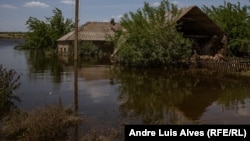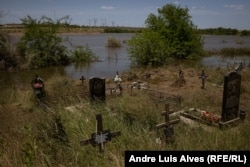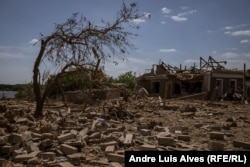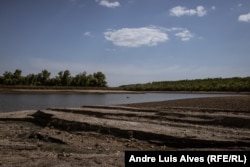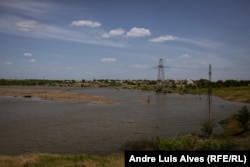ODRADOKAMYANKA, Ukraine -- The cemetery in this riverside steppe village got flooded within hours of the breach of the Nova Kakhovka dam, located five kilometers upstream on the Dnieper River. Three days later, when Mykhaylo Boyarskiy, a farmer from the nearby Kozatske village who used to visit his family graves here, came to the cemetery, he saw wooden crosses and granite monuments covered with mud and rotting weed. An otter was swimming meters away, and the smell of dead fish was in the air.
The breach of the Russian-held Soviet-era hydroelectric dam in the early hours of June 6 unleashed a torrent of water that flooded villages and sparked the evacuation of tens of thousands of people from both sides of the Dnieper River in Ukraine's southern Kherson region. It also caused what many fear is one of Europe's biggest environmental disasters in decades.
Unlike some villages located at a lower altitude down the Dnieper, Odradokamyanka got flooded only to a limited extent. Three days after the dam breach, several houses remained under water, and its artificial lakes spilled deep into the surrounding fields.
"It turns out we kicked them out of here just to get this mess in return," Boyarskiy said in a characteristic mixture of Ukrainian and Russian that is widely spoken here, referring to the Russian troops driven out of the region by the Ukrainian Army last autumn.
Two of Boyarskiy’s friends who preferred not to disclose their identity -- middle-aged farmers taking care of the local animal stock -- were in the village the night the Nova Kakhovka dam was destroyed.
The men with faces tired from lack of sleep said that, after they heard a loud bang, they went to the riverbank with a thermographic camera and saw torrents of water cascading downstream. The farm livestock and wild animals from the other side were trying to swim to the higher right bank of the Dnieper, they said, but the rushing current and whirlpools drowned them.
Russian Soldiers 'Washed Away'
They also said a Russian reconnaissance group that was approaching the Ukrainian-controlled territory with a boat -- a typical occurrence on this part of the Dnieper, which has effectively turned into a front line -- was caught by surprise by the flood and sought rescue on one of the river's multiple islands. "But ultimately, the water washed Russian soldiers away from the treetops," one of the men said.
Boyarskiy came to Odradokamyanka with his comrade Eduard Laktyonov to bring humanitarian aid to some of the 300 remaining in a village that had more than 3,300 residents before Russia's full-scale invasion of Ukraine. Most of those who stayed cannot move out because of old age and poor health.
The mutual exchange of fire across the Dnieper did not stop despite evacuations and rescue missions continuing in the Kherson region. Plumes of smoke hover above the steppes amid the sounds of outgoing and incoming artillery rounds.
"The locals struggle to get by with shells and missiles coming every day and night," said Kostyantyn Kyrychenko, 41, one of the few younger people remaining in the village, which has electricity only from a gasoline power generator and a very limited amount of drinkable water pumped from a local well.
His wife and daughters left for the Czech Republic, while both his son and his brother are serving in the Ukrainian Army. He stays in the village to help older people. His house got partly destroyed by the shells that fell close to it, and he only has a dugout cellar to hide in.
"The only thing I need is for you to bring me new pair of glasses finally," he told Boyarskiy, who handed over a box with food and other products as Kyrychenko gave him a freshly caught fish in exchange.
According to several residents, the Russian Army is shelling Odradokamyanka with mortars, artillery rounds, and missiles, and attacking it with planes daily. Numerous private houses, the school, the village council, other buildings, and an unknown soldier's monument, have all been razed to the ground.
The civilian population of the Kherson region, which first survived the brutal Russian occupation and later lived alongside daily shelling and air attacks, is now bound to face what Ukrainian President Volodymyr Zelenskiy described as "an environmental bomb of mass destruction."
Entire Ecosystems 'At Risk'
This threat is felt acutely in the nearby Kamyanska Sich National Nature Park, a nature reserve named after a historical fortified Cossack settlement that was located in the area, which sits on the bank of the Kakhovka Reservoir.
Ukraine's environment minister, Ruslan Strilets, said that, in some places, the water in the reservoir had moved almost 160 meters away from the shore. Its banks will turn into salt marshes and will not be suitable for the existence of any living things for decades, he said. Ukrainian officials estimate that about 28,000 fish have already died due to the draining.
The director of the Kamyanska Sich park, Serhiy Skoryk, who spent the last months demining the site after the Russian occupation, is now occupied with controlling the water level and easing the collateral damage caused by the flooding.
Three days after the dam's breach, he and his team were removing boxes with explosive materials left by Russians and uncovered under a destroyed bridge after the water level dropped. Dried mussel shells were cracking under the boots of his team pulling the green box with TNT.
The Kamyanska Sich National Nature Park is one of 60 protected areas that suffered because of the breach of the Nova Kakhovka dam, Ivan Moysiyenko, chief of the Botany Department at Kherson State University and a member of Ukrainian Nature Conservation Group, told RFE/RL.
The flooding of areas in the lower Dnieper below the destroyed Nova Kakhovka dam and the drying of the areas above it, as well as the contamination of the Black Sea, will put entire ecosystems of flora and fauna at risk of irreversible loss, he said.
According to Moysiyenko, more than 19 endangered species listed in the Red Data Book and dozens of species protected by the Berne Convention will disappear from these places forever. Hundreds of species and hundreds of thousands of animals and plants will be affected, and in the case of some endemic species, as much as 20 percent of the world population could be extinct, he said.
The environmental disaster will affect territories that have never been under water, such as the Oleshky Sands National Nature Park, Europe's biggest desert, and destabilize places such as the UNESCO-protected Black Sea Biosphere Reserve.
"This is an international ecological catastrophe, and as long as the fighting goes on, not much can be done for the environment," Moysiyenko said.




